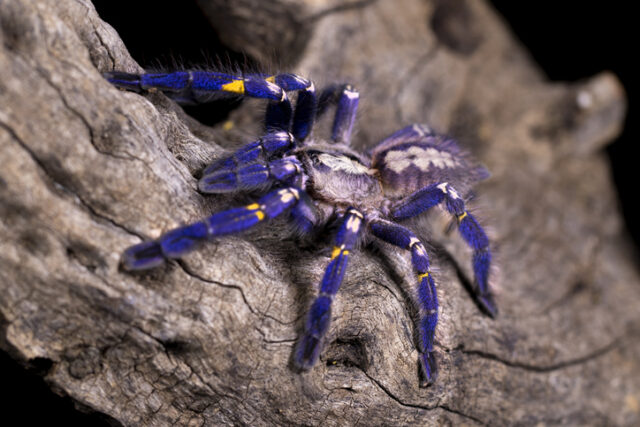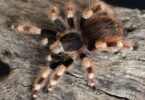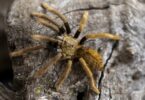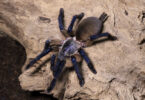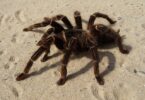Poecilotheria metallica, the Gooty Sapphire Tarantula, is a beautiful and fascinating species native to India. As a tarantula enthusiast with years of experience breeding and caring for spiders, I am here to provide comprehensive insight into this unique blue tarantula.
These medium-sized arachnids are gorgeous creatures renowned for their striking coloration – primarily metallic blue on the abdomen and legs – as well as intricate patterns that create an incredibly eye-catching display.
Even more remarkable are their complex behaviors – including courtship rituals between males and females, communal living among related spiderlings from the same egg sacs.
Unfortunately, due to rampant habitat destruction these exotic invertebrates have been classified by the International Union for Conservation of Nature (IUCN) as Critically Endangered since 2006.
With so few members remaining in the wild, it’s critical we make an effort to protect Poecilotheria metallica before it’s too late. Discover more about this popular pet below -– learn its anatomy traits alongside recommendations on tank/care requirements needed if you’re looking keep one in your home!
Description of Poecilotheria metallica
Gooty sapphire tarantulas, scientifically known as Poecilotheria metallica, are native to the rainforest regions of India – Gooty, Madras. These tasteful arachnid invertebrates have adapted to inhabit trees and other elevated positions rather than burrowing underground which sets them apart from most species of tarantula.
Appearance and Coloration
Poecilotheria metallica, known as the Gooty sapphire tarantula, is a strikingly beautiful species of tarantulas native to India. It’s most unique feature is its incredible blue coloration that covers its entire body – from its carapace down to each leg segment.
This vibrant hue is contrasted perfectly by darker stripes and yellow accents along the sides of their legs. In addition to these vivid colors, P. metallica also has an intricate fractal-like pattern on the abdomen which serves as camouflage in the wild and makes it even more stunning when observed up close.
The bright iridescent shimmering blues are produced through a process called structural coloration where microscopic nanostructures create light interference within each spine layer giving them their distinct shades of purple and blue colors found across different parts of their body—the carapace for example often displays striking purple tones while being near black when seen from another angle or lighting condition.
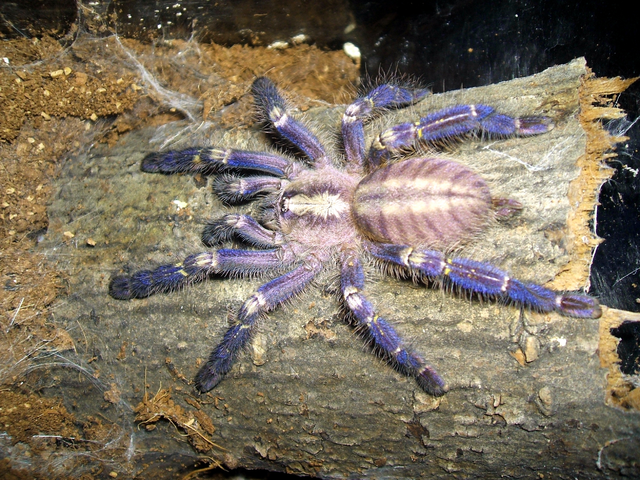
Poecilotheria_metallica.JPG: Morkelskerderivative work: B kimmel, Public domain, via Wikimedia Commons
Behavior and Venom Potency
Unlike many other Poecilotheria species, the Gooty Sapphire Ornamental is considered less defensive and does not display strong warning behaviors such as pressing its legs together before it strikes out in defense at perceived threats.
They tend to be very sensitive to bright lights or sudden movements, often fleeing when provoked.
Poecilotheria metallica has a powerful venom that affects humans with several uncomfortable symptoms. Exposure can cause pain, headache, cramping and sweating accompanied by swelling which may last for a week or longer.
Thankfully this species of tarantula venom does not possess deadly properties but is still potent enough that medical attention should be sought if a person receives multiple bites or particularly severe manifestations of toxicity from one bite.
Habitat of Gooty Sapphire Tarantula
The Gooty Sapphire Tarantula, Poecilotheria metallica, is found only in the tropical deciduous forests of a small area in Andhra Pradesh located in central southern India. These spiders are unique to this region due to their requirement for special environmental conditions with highly varying temperatures and humidity levels.
The majority of hot days exceed 90°F while during cold nights temperatures can drop as low as 60°F. Monsoonal rains are common throughout the year and they bring much needed moisture to their habitat.
With these seasonal fluctuations, plus changing availability of food sources such as insects and beetles, P. metallica must have adaptations that allow them to weather different conditions throughout the year if they wish to survive in this area!
Diet and Feeding Habits
The Gooty Sapphire Ornamental prefers insects that move quickly. Both young and adult specimens can be fed once a week or less frequently if a larger amount of food is provided in the terrarium.
We can feed adults more frequently with large crickets after they molt and if their abdomen changes size. Generally speaking, this species has been observed sealing off its hide with webbing before and during molting periods and may go for several weeks without food – so starvation shouldn’t usually be an issue of concern in captivity.
However, it’s important to provide the tarantula with appropriate meals based on its life stage and size in order to ensure optimal nutrition.
Lifespan and Breeding
The Gooty Sapphire Tarantula, Poecilotheria metallica, has a fairly long lifespan with females living for around 12 years and males for 4 years. Females typically reach a size of 6” in leg span whereas males are usually slightly smaller.
Breeding efforts have resulted in the price of 1” slings dropping to around $30 from its original hundreds-of-dollars value due to its burning blue coloration and unique pattern becoming highly sought after by hobbyists.
To successfully breed P. Metallica, it is important to replicate the rainy season conditions by increasing humidity and temperature levels within the female’s terrarium – this stimulates her to create an egg sac containing between 100 eggs. We place the adult male in the female’s terrarium for 3 weeks, as mating occurs in the morning and the female herself never shows aggression.
There has been much misinformation spread within the trade about a so called “black” variant, yet all colorations actually depend on the age of individual spiders and not their species or type. Specimens that have more black than blue coloration are simply very old individuals.
It is worth mentioning that Poecilotheria metallica can be successfully kept in a group provided that the individuals come from the same egg sac and are kept together from their first molt. However, it is important to remember that the enclosure should not be too large as it may trigger territorial instincts.
Poecilotheria metallica as Pets
While The Gooty Sapphire Tarantula makes a suitable pet, they require special care to be kept comfortably in captivity – with proper equipment and habitat maintenance needed for their health and well-being.
Additionally, knowledge of their behavior is essential due to successful group housing only possible if individuals from the same egg sac are kept together.
Care Requirements
Poecilotheria metallica, commonly known as the Gooty Sapphire Tarantula, require a high level of care to thrive in captivity. As they are from the rainforest regions of India and Sri Lanka, their enclosure should be kept at temperatures between 80 and 85°F during the day with ideally cooler temperatures at night.
It is important to maintain proper humidity levels as well, typically around 70-80%, by misting or using temperature-controlled terrariums fitted with crates or moist sphagnum moss mixtures.
Appropriately sized live food such as dubia roaches or crickets should be provided every 7-21 days for adults while spiderlings in group require more frequent feeding – approximately every 5-7 days.
Tank Requirements
Tank requirements for Poecilotheria metallica must be carefully considered in order to provide the spider with a safe, healthy habitat. Spiderlings should be housed in an arboreal terrarium that is taller than it is wide, containing basic substrate and sphagnum moss, as well as some cork bark for hiding spots.
Good cross-ventilation of the enclosure is essential to prevent humidity build up. As these spiders grow they should be upgraded to progressively larger enclosures until adults such as Gooty Sapphire tarantulas are eventually established in a 2 or 3 gallon enclosure size retrofitted to create an appropriate vertical environment with sufficient protection including hollows and extreme depth into which webbing or burrows can lead down from above ledges and crevices. You can also take the easy route and use a single cork tube, which will be perfect for our tarantula or the entire group.
To maintain a higher level of humidity easily, we should use coconut fiber substrate or mix it with other non-moldy additives for visual appeal.
Conservation Status
Poecilotheria metallica is classified as Critically Endangered by the IUCN, with its population declining rapidly due to habitat loss and illegal collection. The species is found only in a small area of less than 100 square kilometers, mostly within a highly disturbed reserve forest called Gooty in Andhra Pradesh, India.
This beautiful tarantula has also been observed from Chhattisgarh and Orissa states in India but possibly more widely distributed throughout the Indian sub-continent including Nepal and Bhutan.
Being an arboreal species — meaning it typically lives among trees or on rocks — P. Metallica’s main threat is deforestation leading to destruction of their natural shelters which are mostly hollow trunks or branches of dead trees from old plantations.
Illegal smuggling for trade purposes adds up to the difficulty conservationists face towards conserving this unique spider species since they can sell for over $150 per individual making them attractive targets for poachers.
In addition to forests being cleared out, there are other factors that threaten Poecilotheria metallica such as fires started intentionally by farmers during dry seasons causing great reduction in both vegetation cover and insects’ availability; pesticides commonly used by coffee farms located near their sites; adult specimens sometimes fall prey to predators like snakes or birds; settlement expansion ratios have increased drastically compared with those seen two decades ago putting even more pressure on what remains of these endangered habitats all around India.
Currently little action has been taken regarding its decline outside colonies included within protected areas designated since 1996 under Indian Wildlife Protection Act o 1972: however projects like Fauna Worldwide Tarantula Breeding Program work everyday not only promoting captive breeding techniques amongst hobbyists worldwide but also supporting local initiatives against deforestation affecting P oecilotheria populations using money gathered viavoluntary donations helping establishing symbiotic relationships between coffee growers controlling pests without compromising web dwelling densities thus benefit both spiders human farmers respectively .A fundamental aspect enthusiasts can accomplish on contributing directly towards saving this particular species would be following responsible pet practice avoiding buying individuals illegally imported into countries needing permits support organizations setting up informational workshops trying expanding number awareness programs tackling issues related economic importance owning exotic animals specially long live pets demanding constant lifetime care responsibilities crossed freebie purchases.
Conclusion
The Gooty Sapphire Tarantula, Poecilotheria metallica, is a colorful and unique tarantula species native to deciduous forests in Andhra Pradesh. The high demand for this beautiful species on the pet trade has unfortunately contributed to its imperiled population status; currently classified as Critically Endangered by the IUCN due to habitat degradation and overcollection from the wild.
To protect this species, it’s important that all potential owners understand the responsibility of owning such an exotic creature and adhere to ethical collection standards. Captive breeding programs can also help reduce pressure on wild populations if kept in appropriate conditions with knowledge of their lifecycle needs.
Responsible ownership not only ensures these animals receive proper care but helps conserve rare and endangered insects so future generations can continue admiring them in their natural habitats.
Gooty Sapphire Tarantula (Poecilotheria metallica) FAQs
1. Is Poecilotheria metallica good for beginners?
Due to its speed and potent venom, it is recommended for more experienced individuals.
2. How big is the Poecilotheria metallica?
Adult females grow up to a maximum body length of 7 cm and approximately 15 cm leg span, while males are much slimmer.
3. Is the venom of a Poecilotheria metallica dangerous to humans?
Poecilotheria metallica is highly venomous; however, it should not pose a life-threatening risk to a healthy human. Nevertheless, after a bite, one may expect local pain, swelling, severe muscle cramps, dizziness, and nausea.
4. Is Poecilotheria metallica aggressive?
The Gooty Sapphire Tarantula is considered one of the mildest of the Poecilotheria genus, more inclined to flee than assume a threat posture when given the opportunity.

